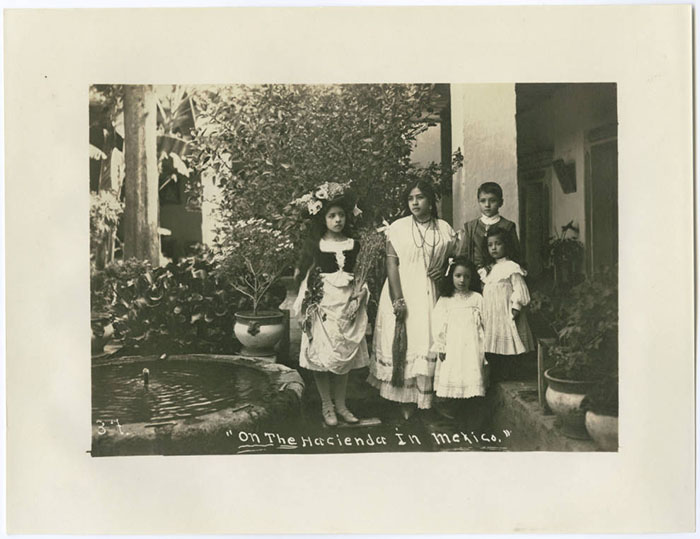
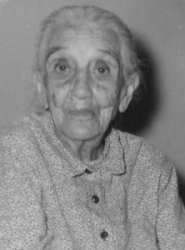
I have always heard, from my dad, from his uncle (the only living sibling of my paternal grandfather), and from that great-uncle’s wife that our family had to to flee Mexico during the Mexican Revolution. Losing everything.
Specifically, this refers to Dad’s grandparents Jose Robledo (1878-1937) and Maria Hermalinda Nieto (1887-1972), and great-grandmother Maria Aurelia Compean (1864-1863).
Jose and Maria, along with their two oldest children (very young at the time), immigrated to the U.S. in 1915.2,3,4,5 Maria’s mother Aurelia followed suit in 1919.6
A Lifestyle Lost
What exactly was the “everything” they lost?
The stories I heard growing up always included references to lost family land…a hacienda, and that the family had been well-to-do back in Mexico.
The 1963 U.S. obituary for my 2nd great-grandmother Maria Aurelia (Compean) Nieto talks about Aurelia coming from a well-to-do family in the state of San Luis Potosí. That same obituary claims Aurelia had 21 children.7 My great-aunt, the wife of the sole living child of Jose and Maria Robledo, was quite close after marriage to my great-grandmother Maria and to my 2nd great-grandmother Aurelia. She says that these women often told her stories about their family life back in Mexico. When my great-aunt asked Aurelia how Aurelia was able to manage 21 children, Aurelia told her the family had servants who assisted with the children. This would indeed indicate that the family was financially well off.
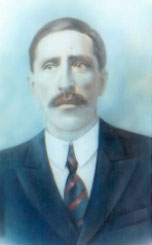
My great-aunt has also mentioned that her father-in-law, my great-grandfather Jose Robledo, never quite recovered from his loss in status. It was a blow to him to come from a lifestyle where he had land and status, to a new country where Mexican immigrants had absolutely no socio-economic status, and to have to struggle to find work that would allow him to provide for the family.
Work opportunities for Mexican immigrants in the 1910s were few. Great-grandfather Jose worked as a dock laborer at the Port of Los Angeles (California) and sometimes as a migrant farm laborer.
The family thinks this blow contributed to his early death.
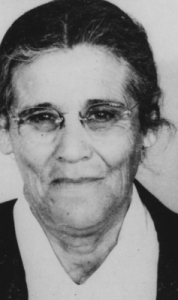
This year, I have learned from others in our extended family network here that Aurelia’s husband, my 2nd great-grandfather Refugio Nieto (1863-1909), committed suicide back in Mexico. I have not found records to verify this claim and these cousins have not provided me with a reason. But I wonder if perhaps the suicide was out of Refugio’s desperation and recognition that the revolutionary changes starting to catch fire in Mexico would soon take away the the family’s land, home, and entire way of life? Did Refugio perhaps have a strong affiliation with the Porfirio Díaz regime–soon to be overthrown? Did he simply suffer from depression? Had he lost his honor?
Refugio supposedly died in 1909. The Mexican Revolution is generally noted as taking place 1910-1920. Talk about pending revolution surely permeated the country in 1909.
RESEARCH TIP: Search Strategy
How will I try to verify if Refugio committed suicide? By conducting a reasonably exhaustive search among the church records, to see if he was buried by the church, and if a parish death record exists. A suicide is not supposed to get buried in consecrated ground, nor would sacramental last rites have been administered or recorded by the priest. The absence of Refugio from those church death and burial records might not mean anything, but that absence could also provide negative evidence. However, I will first try to locate a death record and the specific date date in the civil registrations.
I have no idea what if any bits of truth there are to these stories. Every descendant here of Mexican immigrants from the time of the Revolution wants to believe their family once owned a grand sprawling hacienda. I think it is very likely that my Mexican ancestors did own land there, which may have very well been classified as a hacienda or just a smaller estancia. I doubt I will find that answer out until I visit that area of Mexico next year, where I will hopefully come across old-timers or local historians who may know of the family. I am not well versed enough yet in what type of records might still exist from pre-revolutionary land holdings or might have been created and saved documenting revolutionary land confiscations.
The Hacienda Lifestyle
If my Compean, Nieto, Robledo, and Sanches ancestors had or brought any family photos, paintings, or drawings from Mexico, these either did not survive, or just did not get passed down to my branch of the family lines. So I often seek out imagery that helps me visualize my ancestors’ homes, lifestyles, and travels. Working off the family lore about our ancestors being well-to-do and owning a ranch back in San Luis Potosí, I went looking for photos, videos, and other artwork that depicts life on a hacienda in Mexico from the time of my ancestors.

Depicted below is a hacienda (Hacienda San Javier) from another central Mexico state (Guanajuato), with the Valencia silver mine in the distance. The photo is dated 1905-09, also from the time when my ancestors still lived in Mexico. Mining was quite prevalent in their home state of San Luis Potosí. I wrote a couple months ago about my great-uncle Juvenal Joseph Nieto (1898-1978)–son of Aurelia Compean and José Nieto, younger brother to Maria Hermalinda Nieto–who left home at a young age to work in the mines of Mexico, eventually making his way up to the copper mines of Butte, Montana by the time he registered for the U.S. World War I draft in 1918.
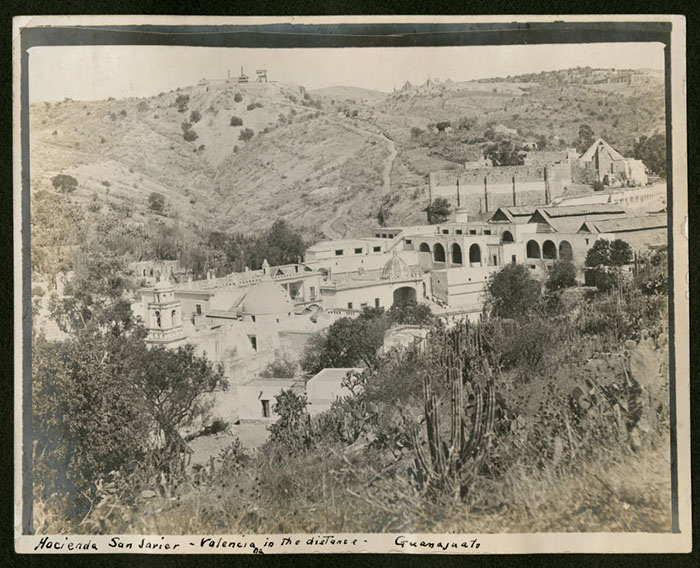
This photo of Hacienda Peotillos was taken sometime between 1880 and 1897, the time when my 2nd great-grandparents married, and had their first children.
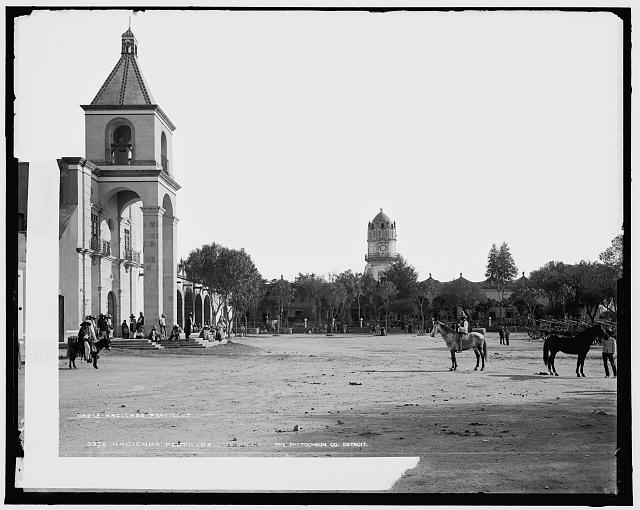
This video–produced by a website about travel and culture in central Mexico–provides a wonderful look at the the geographic area where my family lived, and what their lifestyle might have been like. It also showcases different types of records pertaining to the hacienda, which may prove helpful in my own research.12
The video below provides another look at Hacienda de Peotillas, from a travel reporter.13
Sources
- DeGolyer Library, Southern Methodist University, “On the hacienda in Mexico” Central University Libraries (CUL) Digital Collections (http://digitalcollections.smu.edu/cdm/singleitem/collection/mex/id/536/rec/5 : accessed 20 July 2019). ↩
- Ancestry (http://search.ancestry.com/search/db.aspx?dbid=1082 : accessed 30 March 2015 ) > Border Crossings: From Mexico to U.S., 1895-1964 > A3379 Laredo, Texas, 1903 – 1929 > 092 > image 4184, José Sanchez (Robledo), Laredo, Texas, 27 October 1915. ↩
- Ancestry (http://search.ancestry.com/search/db.aspx?dbid=1082 : accessed 30 March 2015 ) > Border Crossings: From Mexico to U.S., 1895-1964 > A3379 Laredo, Texas, 1903 – 1929 > 070 > image 612, Maria Nieto, 27 October 1915. ↩
- Ancestry (http://search.ancestry.com/search/db.aspx?dbid=1082 : accessed 30 March 2015 ) > Border Crossings: From Mexico to U.S., 1895-1964 > A3379 Laredo, Texas, 1903 – 1929 > 092 > image 3196, Guadalupe Sanchez (Robledo), 27 October 1915. ↩
- Ancestry (http://search.ancestry.com/search/db.aspx?dbid=1082 : accessed 30 March 2015 ) > Border Crossings: From Mexico to U.S., 1895-1964 > A3379 Laredo, Texas, 1903 – 1929 > 084 > image 108, Refugio Robledo, 27 October 1915. ↩
- Ancestry (http://search.ancestry.com/search/db.aspx?dbid=1082 : accessed 30 March 2015 ) > Border Crossings: From Mexico to U.S., 1895-1964 > A3379 Laredo, Texas, 1903 – 1929 > 016 > image 1385, Aurelia Compe__ (Compean), Laredo, Texas, 14 March 1919. ↩
- “Matriarch Dies at 105; 21 Children,” (Long Beach, California) Independent, 19 February 1963, p. A-1, col. 5. ↩
- DeGolyer Library, Southern Methodist University, “Hacienda San Diego, Rio Verde, S.L.P.,” Central University Libraries (CUL) Digital Collections (http://digitalcollections.smu.edu/cdm/singleitem/collection/mex/id/1835/rec/2 : accessed 20 July 2019). ↩
- DeGolyer Library, Southern Methodist University, “Hacienda San Javier – Valencia in the distance – Guanajuato,” Central University Libraries (CUL) Digital Collections (http://digitalcollections.smu.edu/cdm/singleitem/collection/mex/id/1231/rec/7 : accessed 20 July 2019). ↩
- Iglesia Católica (Catholic Church), San José, Información matrimonial 1880-1886, p. 218, Refugio Nieto and Aurelia Compean, 18 October 1883; Archivo Diocesano (diocesan archive), de San Luis Potosí; digital image, FamilySearch (https://familysearch.org/search : accessed 6 May 2015) > Mexico > San Luis Potosí, Catholic Church Records, 1586-1977 > Villa Hidalgo > San José > Información matrimonial 1880-1886 > image 491. ↩
- Library of Congress, “Hacienda Peotillos,” Prints & Photographs Online Catalog (http://www.loc.gov/pictures/item/det1994000272/PP/ : accessed 20 July 2015). ↩
- MexiTV, “Haciendas Mexicanas: Hacienda Peotillos en San Luis Potosí,” Vimeo (https://vimeo.com/97979656 : accessed 19 July 2015). ↩
- Reportajes de Alvarado, “Hacienda de Peotillos en Villa Hidalgo SLP,” YouTube (https://youtu.be/DlnQU-5kHSI : accessed 19 July 2015). ↩

What an interesting blog post! I stumbled upon your website from a genealogy group on facebook, and decided to check out your blog. I really like your style here of posting both facts and hunches. It inspires me to start my own family history blog.
Hi Kristen,
I apologize for this VERY late reply to your very kind comments. Did you start your own family history blog? I have had no time to blog the past couple years, but my family blog continues to bring me regular family history clues from the people who find my posts and share comments. I do recommend it! Plus, writing out what you know in a narrative form really helps us synthesize our research better.
Colleen
Very nice work…a labor of love…just like the lady above I to stumbled upon your blog…looking for information on my family…I’m so happy that I found your website…thank you for sharing your work with us
Hi there, I just got back from visiting family and doing my own research in El Temascal, San Luis Potosi. I learned that your ancestor, Refugio Nieto, killed himself there upon gambling his land. Apparently, the hacendados gambled often, including with the priest. This information comes from a local who continues to live there, specifically in what remains of the hacienda. His mother worked all her life for the family and he knows much of the family’s history. The owners, Nieto, are now in Mexico City.
All this may be related with the family of Pascual Nieto, married with a lady Compean in the 1880’s. Pascual was the father of Rafael Nieto Compean gobernor of San Luis Potosi, (1920-1923) The governor was born in Cerritos, a town close to the then Villa Iturbide (Now Villa Hidalgo) and San Nicolas Tolentino. The Nieto Family lost the hacienda Joya de Luna expropiated by the “Revolucionary” government in 1927. My family may be related to this Compeán families, my father was Lorenzo Banda Compean, son of Teófilo Banda and Sóstenes Compeán of Tepozan, Cerritos, San Luis Potosí, (none apparent relation with the governor family), We have a far family relation with Justino Compeán Nieto, of San Luis Potosí, who until few years ago was a very important leader in the Mexican National Soccer Leagues. Rafael Silva Nieto, grandson of Rafael was also governor of San Luis en 1996-2001, and Cerritos, has had at least three mayors named Compeán.
Hi,
I too stumbled upon your blog. I have been doing my own family tree as well. Our paternal side comes from San Luis Potosi as well. We come from the Conde de Santa María de Guadalupe del Peñasco. They were all hacienda owners. My great grandfather was murdered by Carranza during the revolution. They lost their land as well. My grandfather, his oldest son, went to Ensenada in his adult life and carved out another hacienda only to have it taken away as well by the Mexican government.
Your story is very interesting and similar to mine (what we were told).
Hello. I was reading your blog and it’s very interesting. I wonder if we’re related down several generations. My fathers father Eleuterio Nieto was also from San Luis Potosí. He and his family had to flee because of the Mexican Revolution. My father Jesus would talk about his fathers home. From my understanding they had a hacienda like you mentioned. My grandfather and his family settled at Austin, Texas.